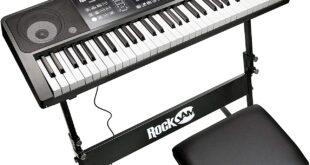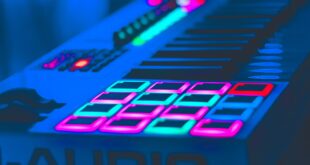Weighted keys are a feature used in the design of digital pianos (and some keyboards/portable pianos) to help stimulate the action of an acoustic piano. As you can see in the illustration above, pushing a key on an acoustic grand piano set-in action a series of mechanical pieces with the goal of firing a hammer against the string (s). This produces a recognizable piano sound and gives a pianist the amount of control needed to achieve a wide range of expressive options.
These are keys with weights added to imitate the intricate mechanics that occur when a key is depressed in an acoustic piano – a series of levers eventually causing a hammer to strike a grouping of two or three strings. When you play the piano, you can feel a natural weight or resistance that helps you gauge how hard to hit a key to achieve the sound you desire. The note will be mild and less strident if you strike with a delicate touch; if you strike with more power, the hammer will contact the strings harder, resulting in a louder, brighter sound.
Table of Contents
Why are weighted keys better for beginners than those of a keyboard?
Weighted keys, as opposed to those on most keyboards that are unweighted, will bring the beginner pianist closer to that of an acoustic piano, allowing them to experience the sensitivity required to push down the keys with varied levels of control. Unweighted keys do not give the necessary resistance for developing piano skills.
To get a strong start on developing their piano technique, the student should feel that they are pressing against the key when playing a note, as well as the key pushing back up when returning to its resting position. On a broader scale, it’s similar to the experience of sitting on one end of a seesaw.
Many keyboards have unweighted keys, which do not produce this sensation, resulting in a student practicing on an instrument that does not mimic the key resistance of an acoustic piano. When they begin to play for their teacher on a weighted action, for example, they are typically taken aback. Because their fingers aren’t strong enough to move from one note to the next, the evenness of their playing can suffer, affecting the dynamic level and tone they generate from the instrument.
What are the different types of weighted keyboards?
If you’re new to the piano or keyboard, knowing the different types of weighted keys and weighted keyboards available will help you make the best decision when choosing your keyboard. The different stages of weighted keys are these four levels: There are a few primary types of keyboard keys, and the different stages of weighted keys are these four levels:
- Not weighted
Most MIDI keyboards and cheap keyboards lack a weighted action keyboard, but this can occasionally be found on professional studio and stage keyboards. When a keyboard is not weighted, no weights are used in the key bed, but it still has a touch and velocity-sensitive keyboard so you may enjoy responsive sounds.
- Semi-weighted
A semi-weighted action is found on most keyboards above the ‘beginner’ level. A sprung-action key with more resistance than an unweighted keyboard is used for this. This results in a considerably more responsive playing experience to your touch. You’ll notice a difference if you can stretch your budget to semi-weighted keyboards.
- Hammer action keyboards
When a digital piano or stage piano claims to have a hammer-action keyboard, it signifies that the keys feature a mechanism that mimics the hammer action of an acoustic piano. This is commonly accomplished by attaching a lever mechanism near the key to increase the resistance of the keys being played.
- Graded weighting
On acoustic pianos and some higher-end digital and stage pianos, graded weighting is a standard feature. When playing keys on an acoustic piano, you’ll notice that there’s greater resistance in the lower range and less as you move up to the higher ranges. The low-end notes on digital keyboards and digital pianos will require a harder touch, whereas the higher notes will require a lighter touch. Individually weighted keys are commonly used to improve playability and simulate the feel of an acoustic piano. Keys on digital pianos with graduated weighting are frequently constructed of wood rather than plastic. Some choices, on the other hand, include keys that mimic the feel and weight of ivory.
The benefits of weighted keys
Players must experience the sensation of pushing against a key to play a note, as well as the sensation of the key pushing back up when returning to its resting position, in order to develop appropriate piano techniques. Weighted keys are the only way to accomplish this with a digital instrument. Weighted keys promote finger strength in the same way as lifting weights in the gym promotes arm, back, and leg strength. The premise remains the same: lifting heavier weights makes lifting lighter weights easier. For the casual player or someone who merely wishes to play organ or synthesizer, non-weighted keyboards may suffice. However, if you only learn or practice on non-weighted keyboards, making the switch to acoustic piano will be challenging. If you want to learn to play the piano, weighted keys are the only way to go.
Should I buy a weighted keyboard?
Before you go out and buy a weighted keyboard, you should consider whether you can stretch your budget to cover the additional expense. As a musician, you must also examine your objectives and requirements. You probably don’t need weighted keys if you merely want something to record or perform live with and don’t need the response and feel of an acoustic piano. If you plan to travel with your piano regularly, you should consider getting a keyboard with either non-weighted or semi-weighted keys, as these are much easier to transport. If you’re starting to play the piano and are serious about it, need a piano for around the house, or want to study music, a weighted keyboard is the way to go.
Weighted keyboards operate in a similar way to gym training in that they improve finger strength. The heavier the weight you lift, the easier it is to lift lower weights. With that stated, if you solely play non-weighted keys, your finger dexterity and strength will be limited to non-weighted keys, and playing a weighted keyboard may feel jarring. This is something to consider when selecting your keyboard, as unweighted keys will not help you develop the strength required to play a concert grand piano.
Fully-Weighted Vs Semi-Weighted
To comprehend how digital keyboards function, we must first comprehend some basic keyboard vocabulary. Semi-weighted and fully-weighted actions are two forms of weighted actions to evaluate. Although semi-weighted and fully-weighted keys may appear to be the same, they are not.
When working with semi-weighted keys, the resistance of the keys is noticeably different. Semi-weighted keys have a spring mechanism as well as weights attached to each key. It will feel almost effortless when a pianist depresses the key.
The keys depress swiftly, but as they rise back up, they feel sluggish. As a result, it can be difficult to execute some pianistic techniques such as glissandos or fast repetitions.
The action of a digital piano does not have the same level of resistance and weight as an acoustic piano.
The fully-weighted action is similar to the semi-weighted action, but it has additional resistance to improve the sensation while playing. The keys on these keyboards are usually of the same weight. Weights have been put beneath the keys to offer extra resistance, and the return springs have been strengthened. The pianist’s purpose here is to maintain his or her playing endurance.
Finally, there are keyboards with hammer action that are fully weighted. The goal of these keyboards is to create the most authentic touch experience possible. They are constructed with hammer mechanics and weights to accomplish this.
This significantly increases the feel and resistance of each key, making them feel distinct. Some keyboards, for example, have more resistance in the bass notes and less resistance in the treble notes, similar to a real acoustic piano. This is referred to as “scaled hammer action.”
Why is Hammer Action Better?
If you don’t want to buy an acoustic piano and instead want to buy a digital keyboard, make sure you pick one with hammer action.
Hammer motion will help you build your muscles as a pianist in terms of general development.
Hammer motion is crucial for getting a real feel for acoustic piano playing whenever you come across one.
It’s almost as though learning the piano is a sport. The equipment we utilise has a direct impact on our ability to develop. Hammer action keyboards allow us to create a distinctive sound, play precise dynamics, and execute articulations such as staccatos, accents, and legato.
Those performance elements would be difficult to achieve if the keyboard was semi-weighted or completely weighted without hammer mechanisms.
A digital piano with hammer action does an excellent job of capturing what we do with our hands and arms and reproducing it accurately.
These keyboards can immediately calculate the amount of force you use, give realistic key depth, and provide the correct type of rebound and resistance to make it feel like the real thing, thanks to today’s technology.
A pianist who trains on a piano with equal weight across the keys or a delayed release will not be prepared to play acoustic instruments in the future. Acoustic pianos don’t function like that.
An acoustic piano will feel virtually foreign to a pupil whenever they attend to a piano lesson or desire to deliver a stage performance. Because their muscle development isn’t there, the speed at which they play would feel like a strain. Furthermore, establishing dynamics will be a challenge for them.
Concerns With Hammer Action Pianos
Even while I adore hammer action keyboards, I have to agree that they aren’t without flaws. Its purpose is to emulate the sound of an acoustic piano, but it will never be completely accurate.
As someone who has owned a variety of keyboards, I can declare without a doubt that hammer action is the clear winner. Here are some of my reservations about digital pianos.
- Synthetic Keyboard Action Has Become Too Familiar
My main concern is that pupils will become too accustomed to the synthetic motion rather than the actual thing. Some families, for example, have both acoustic and digital pianos in their homes.
That family’s inclination is likely to be to send their student to the other room, where they can play quietly with headphones.
The issue with this scenario is that if the pupil does not have enough exposure to an acoustic piano, they may acquire bad playing technique.
If you want to buy a piano with this type of action, you’ll need to make an effort to balance out your practice.
Even those who own hammer action pianos should think about how to expose their student to more actual acoustic pianos, preferably a grand if possible.
- Size And Weight
When purchasing a hammer action piano, you will almost definitely be purchasing a complete console setup. These consoles take up a lot more space than a cheap keyboard on a music stand. They’re about the size of a normal upright piano, with a width of 5 feet and a height of 4 feet. Some of the larger consoles can weigh up to 150 pounds, so you might need assistance carrying it about the house. These consoles, particularly the Yamaha Clavinova, are essentially pieces of musical furniture in my opinion.
Although it isn’t as large as a grand piano or a typical upright, you’ll need to make room in your home for it.
- Price
Another significant downside of these pianos is their cost. You won’t be spending tens of thousands of pounds as you would on a Steinway, but you can expect to pay a significant sum.
Some of the most affordable digital pianos are approximately £400, although they frequently lack “hammer action.” The more realistic the piano appears to be, the more it will cost. It’s more true to say it’s between £1500 and £2500.
This may seem exorbitant, but an upright piano cost between £3000-£4000, thus the cost of a digital piano is a drop in the bucket. Other factors that contribute to the high cost of some consoles are the hardware and software included in those systems. They boast state-of-the-art surround sound speaker systems in several of them.
Sound filters are also included, allowing pianists to perform in recital halls, outdoors, and other settings. Some Yamaha Clavinova pianos come with built-in lessons and plenty of accompanying options to keep a young student occupied for hours. That may appear to be a lot, and it is in certain cases, but for the price, it is a great deal.
Understanding Weighted Keys
When playing the piano, you must press the keys hard enough to send a hammer through two or three strings. The note is produced when the hammer strikes those strings. Each key is connected to each hammer by a lever mechanism, which gives the keys a sense of weight.
If you’ve ever used a keyboard without weighted keys, you’ll understand how the lack of the weighted sensation of a real piano can be perplexing at first. Keyboard keys are meant to rise back up after being depressed, and they can be depressed with less force than a piano key.
If you’re switching between a keyboard and a piano, this can be a problem, especially if you’re practising on a keyboard at home and then need to play on a piano in music classes or during a performance. The transition between the two extremely different keys is challenging, and because they feel so different, it can damage your finger and dynamic control.
Purchasing a Weighted Keyboard
For piano students, a keyboard with weighted keys is well worth the money. They’re an important investment in your musical education and will help you grow as a musician.
Weighted-key keyboards are more expensive than non-weighted-key keyboards, but the benefits far outweigh the price difference. A weighted key keyboard is a must-have for several reasons, including making it simpler to transfer from the keyboard to the piano, developing vital finger strength and dexterity, and learning to precisely control dynamics. While your keyboard will be an investment, it will still be less expensive than buying a good piano.
If you’re in the market for a keyboard, talk to your music teacher first. You’ll have a variety of keyboards to pick from, each with its own weighted key mechanism, key action, and features. The best method to select the correct keyboard for you is to seek guidance from your teacher, who will be able to guide you in making the best decision depending on your needs and musical ambitions. A high-quality keyboard can last you for years, so it’s definitely worth the effort to save up for one.
Best Digital Pianos with Weighted Keys
Technical Details
Brand: Donner
Product Dimensions: 144 x 35 x 24 centimetres
Connectivity Technology: Auxiliary, MIDI USB
Item model number: DEP-20
Colour: Black
Style: 88 Keys
Item Weight: 15.3 kg
Technical Details
Brand: ZHRUNS
Product Dimensions: 125 x 30 x 10 cm; 11 Kilograms
Connectivity Technology: USB, MIDI USB
Colour: Black
Style: 88 Keys
Item Weight: 11 kg
A digital piano that’s tailored to you: Feature-packed electric keyboard with 88 premium full-sized semi weighted keys with adjustable touch response to suit your preferred playing style. Five voices (acoustic piano, electric piano, organ, synth, and bass), built-in FX: Chorus, reverb, and two built in 20 W speakers that deliver crystal-clear, room-filling sound. ¼ Inch sustain pedal input (not included), ¼ Inch stereo headphone output for private practice and stereo RCA outputs for connection to speakers / amplifiers. Power via the included power adapter or 6 D cell batteries (not included) for professional piano performance wherever you are. Standard, split, layer, and lesson modes with 128-note max polyphony and Skoove 3 month premium subscription for expert interactive online piano lessons. 60 free virtual lessons from Melodics to hone your skills for any genre or technique you want to master.
Technical Details
Brand: Alesis
Product Dimensions: 9.1 x 29.3 x 128.3 centimetres
Item model number: Recital
Colour: Black
Style: 88 Keys
Batteries: 6D batteries required.
Item Weight: 7.1 Kilograms
Technical Details
Brand: Korg
Product Dimensions: 131.2 x 33.6 x 11.7 centimetres
Item model number: B2 BK
Connector: 1/4-Inch Stereo
Hardware Interface: Micro USB Type B
Colour: Black
Style: B2 Piano
Output Wattage: 15 Watts
Item Weight: 11.4 Kilograms
Technical Details
Brand: Donner
Product Dimensions: 139 x 47 x 28.5 cm; 8.6 Kilograms
Item model number: DEP-10S
Colour: Black
Style: 88 Keys
Size: Piano+Furniture Stand+Triple Pedals
Connectivity Technology: Auxiliary
Item Weight: 8.6 Kilograms
 The Occasional Orchestra Learn About Everything Music!
The Occasional Orchestra Learn About Everything Music!








